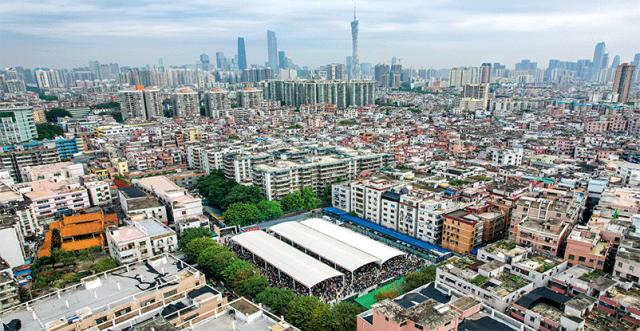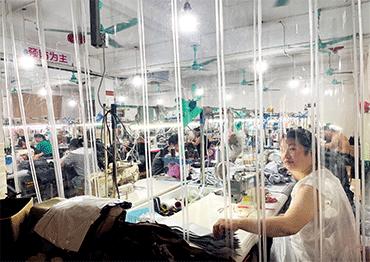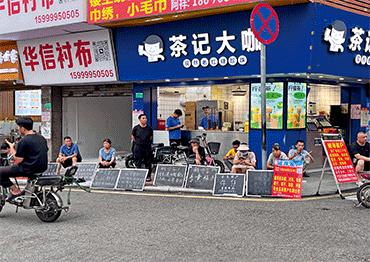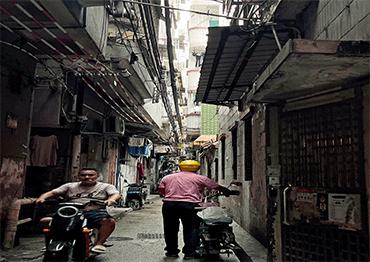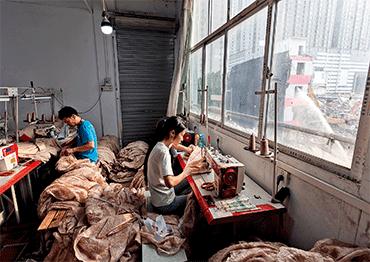In 2022, Haizhu District announced that the garment industry based around the Zhongda Market cluster should shift to Qingyuan, a city in central Guangdong.
Qin Mian, who came to Guangzhou 11 years ago and owns a 600-squaremeter factory in Lujiang Village, decided to investigate Qingyuan. He found new, spacious factories and cheaper rent than Kanglu. But he is not persuaded of the benefits. “How can it work if you only move the factories and not the suppliers of goods and supporting industries? We could lose our orders,” he said.
Amid the demolition countdown, some factory bosses considered moving back to Hubei Province. In 2023, places like Xiantao and Jingzhou in Hubei offered policies to support and attract the garment industry. But opening factories in Hubei is not easy either.
Lin Yisheng, originally from Jingzhou, operates a small workshop near Kanglu with his wife, brother and sister-in-law. His brother tried to establish a business in Jingzhou and took an order for 5,000 garments, but he ended up losing 140,000 yuan (US$19,700). With no local suppliers, he had to ship materials from Guangzhou and pay the freight.
But the biggest problem was the lack of competent workers. Lin’s brother found that workers in his hometown were slack. He said they played mahjong whenever they liked. The order took him around six weeks to finish, though it was supposed to take 20 days. The customer canceled the order, and he had to sell the finished clothes at a very low price. Lin’s brother said moving to other cities might be suitable for companies with stable orders and workers, but not for them. “We’ve given up on the idea of going back.”
Liang Fubin of the HCCG visited Qingyuan several times to check it out. He suggested authorities there should attract big garment companies from a national or even global scope, pointing out that companies in Kanglu are small and heavily dependent on the supply chains around the big textile market. In addition, garment wholesale markets and stalls in Shahe, one of the biggest clothing wholesale distribution centers in Guangdong, are highly dependent on garment factories in Kanglu because of its efficiency. “If the capacity in Kanglu shrinks, transfers or disperses, it might also cause the decline of wholesale markets in Shahe and similar places. The whole industrial chain is interdependent,” Liang said.
Authorities are weighing the pros and cons. Liang said that since July 2023, attitudes from Haizhu District and Qingyuan have shifted over requiring textile firms to move, a signal that some industry could remain in Kanglu and even in downtown Guangzhou.
Jiang Hao believes that authorities should neither force industry out nor keep things as they are. He suggests the local government should assess the value of the industries objectively and explore ways to push forward industrial transformation while respecting the present situation.
As the realities of the slowing economy become apparent, many local governments are reassessing how they deal with labor-intensive industries. There is a new focus on improving conditions instead of trying to replace them with high-end manufacturing.
In December 2023, Haizhu District approved a development plan which intends to ensure quality companies upgrade on-site. To keep its industrial advantages, the plan proposes to retain some of the key production processes, optimize the structure of companies, build digital supply platforms and emphasize branding and design incubation.
Xu Lige, general manager of Guangzhou Urban Planning and Design Company Limited, which is involved in the Kanglu redevelopment, told NewsChina that previous village transformation projects in Guangzhou stripped out industry entirely, but the plan for Kanglu will retain dedicated industrial space.
According to Haizhu District, 1.45 million square meters will be reserved for industrial development.
Planners are looking at what the final industrial mix will look like in Kanglu. Wei Huili from GRID said that given the limited space, not all factories can stay. Priority will be given to companies that will best contribute to economic growth.
In the future, garment factories in Kanglu will need to operate in compliance, putting an end to chaotic management. According to Liang Fubin, over 10,000 factories and workshops there run without a license or paying taxes. Daily wage workers do not have employment protections, nor does their salary include contributions for benefits like healthcare or pensions. From placing orders to shipping, the business is mainly conducted through oral contracts.
In July 2023, Haizhu District’s official in charge of the transformation said in a seminar held by HCCG that garment factories in Kanglu will need to comply with regulations and upgrade in scale. A pilot project near Kanglu is encouraging small workshops to sign up to a digital platform to accept orders online, either in cooperation or independently.
“It will be like a supermarket full of household brands. The factory can take orders as one or separately, but it will appear as one firm to the outside,” Liang Fubin said. He believes embracing digital transformation will allow small companies to survive and be in compliance. If it works, they hope the program will spread to Kanglu.
Wei would like to see Kanglu cultivating its own designer brands that take advantage of its efficiency. She stressed the importance of protecting the local industrial ecology featuring small orders and quick responses, including day workers that factories rely on and can find quickly. If the rent rises to thousands of yuan a month after buildings are reconstructed, this will deter the flexible workforce who rely on cheap lodgings.
“Our team will look at other urban villages nearby to see if the workers can move there. If Haizhu District wants to keep its industrial ecology, it needs to provide affordable accommodation,” Wei said.
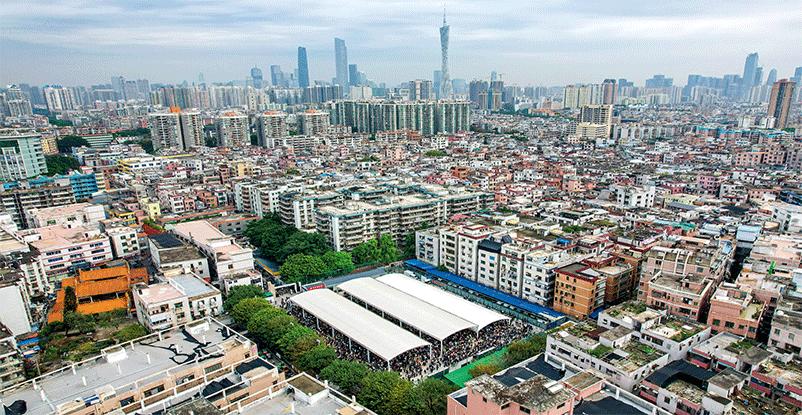
 Old Version
Old Version
